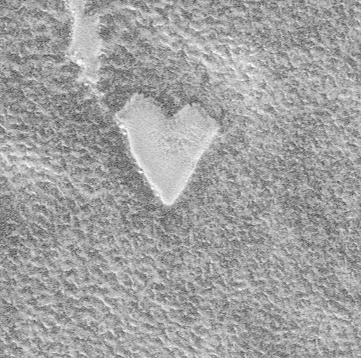

MGS MOC Release No. MOC2-207, 11 February 2000

Earlier in 1999, MGS MOC saw another valentine heart, but instead of a mesa, the feature was expressed as a pit. You can view that image by CLICKING HERE.
Note added 1:45 p.m. PST, 11 February 2000:
If the heart looks to you like it is a pit (negative relief) rather
than a mesa (positive relief), that is because there are two effects
that make this a challenging object to see. Sunlight illuminates
the heart from the lower left, thus the lower left wall of the heart
looks bright because it is reflecting this sunlight. The problem
here is frost. Some very small amounts of residual frost are seen on
the slopes facing away from the sunlight (toward the lower right and
toward the top). MOC images in the martian polar regions can sometimes
fool the eye because a frosted slope might at first glance seem to be
a sunlit slope. This picture was taken in late southern spring in a
region that spends each winter and most of each spring completely
buried in bright frost.
Malin Space Science Systems and the California Institute of Technology built the MOC using spare hardware from the Mars Observer mission. MSSS operates the camera from its facilities in San Diego, CA. The Jet Propulsion Laboratory's Mars Surveyor Operations Project operates the Mars Global Surveyor spacecraft with its industrial partner, Lockheed Martin Astronautics, from facilities in Pasadena, CA and Denver, CO.